Heading Up the Coast
Our next stop was Aveiro but first we wanted to make a stop in Costa Nova. We somehow managed to stuff 3,000 lbs. of luggage into the rental car, wedged Mary and Mike in the back seat and headed off. Costa Nova is an absolutely adorable beach town in which most of the houses are painted in stripes. Yellow and white, black and white, red and white and so on. We all wondered who started this unique approach to house painting but whoever it was, was a genius. After an abundant lunch of excellent seafood we took a walk to the beach and then headed to Aveiro to our hotel.
 |
| The abundance of the striped houses is evident in these photos. |
 |
| To protect the dunes they have installed this boardwalk to the beach... |
 |
| where people were enjoying the warm day. |
 |
| One of the houses had this plaque to Saint Anthony... |
 |
| and a picture of Saint Anthony on the front of the house. This house was covered in tiles and was not on the main street with the striped houses. |
I doubted our GPS because it kept directing us away from the canals for which Aveiro ("the Venice of Portugal") is famous. I KNEW that our hotel was on a canal. We parked in the world's smallest and most challenging garage and went to reception where I fully believed they would say we were in the wrong place. But no. It was our hotel. "But where is the canal?," I whined. Mary looked out the window. "Deirdre, what you thought was a canal is a koi pond," said Mary. And yes, there it was boasting a herd of koi. Damn that macular degeneration! The hotel was charming in a faded glory kind of way and we settled in.
The Best Dinner Ever
I had researched some restaurants in Aveiro and was intrigued by the #1 listing. It was described as a food truck on a farm that could only handle 40 people and required 3 days prior reservation. Michael sent an email and the owner said that while they had a wedding scheduled for our date she would figure out a way to accomodate us. We drove out into the country and followed a few winding, miniscule roads and arrived at the farm gate. We were greeted warmly and invited to walk around the farm and, when having completed patting goats and admiring barnyard animals we headed back towards the entrance. There a young woman greeted us and said, "We have the wedding in the main restaurant but we'd love to serve you dinner in the owner's home. Is that OK?" "You bet," we replied as one. We settled into a large table lit by candles and chandelier and sipped local wine. We had our own dedicated server who both manned the stove and the table. I can't even relate every course that we had but it was absolutely one of the best meals I've ever had. At the end, the owner came and we chatted for a long while about how she and her husband ended up with the farm and restaurant and about our families and how we were enjoying Portugal. Her husband was the chef and a fire fighter. I'm sure he was busy in the following days but we will get to that.....
 |
| The setting was bucolic... |
 |
| and the pygmy goat came to greet us... |
 |
| as the sun was setting over the pond. |
Not Exactly Venice.... But Nice
Aveiro is a coastal town nestled beside a lagoon and featuring a series of canals. In the day it was a center of salt harvesting which was vital because the country depended on fishing and salting the fish was the only way to preserve it over time. Very attractive boats called Moliceiros ply the canals ferrying tourists hither and yon. They are much larger than gondolas but structurally are somewhat similar. The town is a good one for just roaming around which we did for two days.
 |
| The buildings with their adornments were quite notable... |
 |
| as this closeup reveals. |
 |
| The figurines on the Bank of Portugal were even more notable. |
 |
| The motor scooter is a favored form of transportation in Aveiro. |
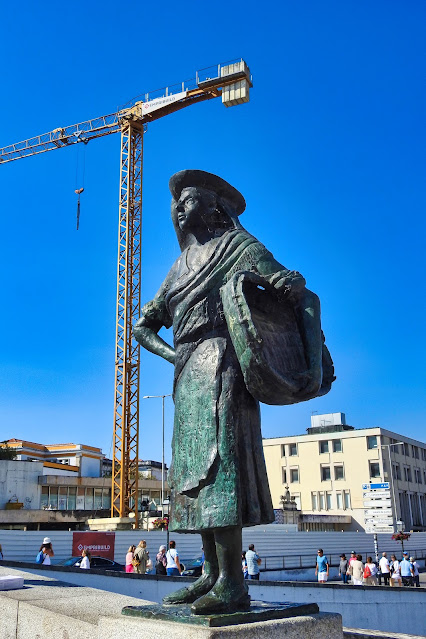 |
| The bridge over the canal features two statues. This one of a woman with a basket used in the salt industry... |
 |
| as well as this man with his tools used in the salt industry. |
 |
| A moliceiros on the canal. They are all painted with bright colors. |
 |
| This old building was an old salt warehouse, when this was a major industry in Aveiros. |
 |
| All the buildings along the canal were unique and different... |
 |
| with some very interesting facades on some of them. |
 |
| Instead of locks professing love for one another, these two bridges featured ribbons of different colors. Much better for the bridges! |
 |
| The tile work... |
 |
| the imaginative paintings... |
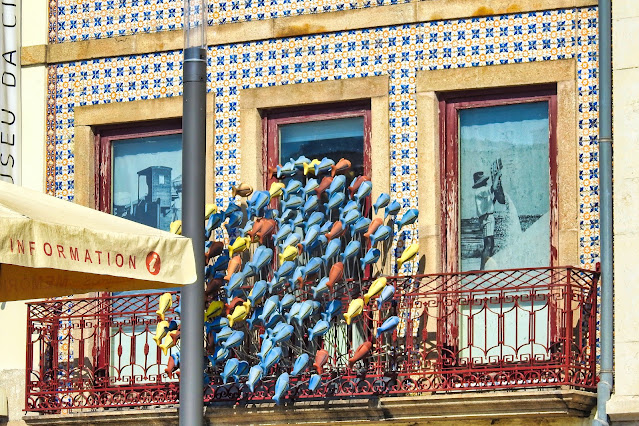 |
| and even the sculptures... |
 |
| and characters along the canal made for an entertaining sojourn along the canal. |
 |
| This church featured two azulejos (blue tile) pictures... |
 |
| whose detail is revealed in this photo. |
 |
| As in Lisbon many of the building fronts are covered in tiles. |
 |
| This creative structure was holding up a footbridge across the canal. |
The third day we wanted to visit a town North of Aveiro but south of Porto where we would head the following day to board our boat for a Douro River Cruise. Before heading out, I pulled back the curtain to survey the weather. The sky was a vibrant blue and clear except for one large, very black cloud. I pointed it out to Michael. "Yeah, that's kind of weird," he said. As we were about to get the car we heard two women talking with the desk clerk. He was telling them that the roads to Porto were closed due to massive wildfires which were scattered from the north to south of Portugal.
Typically we decided to set forth anyway. By the time we got the car and headed out of town ash was falling like rain. We made it about 10-15 miles north and then we saw many, many firetrucks and police and military rerouting traffic. We pulled into one parking lot and there were fire fighters totally black with smoke drinking coffee and taking a break. We made one more foray in a different direction and a cop finally told us in no uncertain terms that we were not to go any further. So, we retreated to our hotel to see what we could do about getting to Porto the next day.
Things did not get better. We had to embark on our boat by 2 PM the following day. By nightfall more roads were closed in more directions. We loaded the car in the morning and called our travel agent. We explained the situation and she said that they could maybe hold the boat until 4 PM but others were saying they should move the boat before 2 PM. Michael headed north and we made it about 10 miles before being told we would never make it to Porto. Undaunted we tried a second route. Same thing. We decided to give it one more try and finally managed to get on the one main road they hadn't closed yet. It was a little sketchy. At times we were driving with fires on both sides of the 6 lane road. I kept thinking of the 60 people who had died while driving during a fire in Portugal several years prior. I did not share the info with my car mates. We made it to Porto and the port and let our travel agent know our route. She was grateful because they had a busload of fellow sailers trying to get from Lisbon to Porto. We boarded and had a celebratory drink.
The whole thing with the fires is very baffling. I felt like I was back in Mexico where there are three explanations for everything only one of which may be true. In all cases though there was concurrence that the fires were intentionally set. Explanation #1: "They" burn the wood because then they can buy it more cheaply." Huh? Explanation #2: "The land is protected and you can't sell it while it is forested." We heard this one when we were near forest fires in Greece. Explanation #3: "They burn it so they can mine for lithium which they couldn't do with the forest on it." I was going with this one until we returned to Mexico and I heard someone in the U.S. offer the same lithium line vis a vis the California fires. Come on... quien sabe?
Sallying On to Salamanca
We had never done a river cruise before. Reviews are mixed. The boat was nice. The staff was nice. The food was good. I think our issue with it was that the boat didn't sail at night. What happened was that you sailed in the morning, had lunch, had an excursion (short) in the afternoon and were back by dinner. Others tell us this is unusual and usually you have more time to explore. The locks were fun, the vineyards were pretty but repetitive.
 |
| Outside of this museum was an example of an old rabelo boat used to transport the barrel of port to Porto for shipment overseas. |
 |
| On this particular day the smoke from the wild fires made for an unusual skyscape. |
 |
| There were several areas on the Douro River where it was very narrow and only one boat could go through, requiring scheduling and communication among the boats plying the river. |
 |
| Each winery displayed its name proudly... |
 |
| and, in the case of this winery, also displayed the vats holding the wine. |
 |
| There were multiple locks along the Douro,... |
 |
| many of which required lowering the shade cover, radar, etc. on the top deck. |
 |
| Back in 1815 two Scottish brothers, Robert & John Cockburn, "bypassed the stuffy merchant's fair in Porto and bought the very best grapes directly from the farmers upriver in the Douro". |
 |
| Later they established their own vineyards in the upper Douro River valley. |
 |
| There were many tourist boats cruising along the Douro River. |
 |
| There were not only vineyards galore among the hillsides,... |
 |
| but also olive groves as well. |
The excursions were all pretty far from the boat requiring long bus rides that cut into the overall excursion time. They also took a boatload of ancients to a hill town (Castello Rodrigo) that makes Italian hill towns look like babies. At one point, balanced on a slope that looked like a black diamond ski run an oldster begged the guide to stop talking and let him descend before he toppled down. At that point, Michael tapped me and pointed to the ground. I saw a pool (sizable) of uncongealed blood. Apparently another oldster had bit the dust at this point.
 |
| The vestiges of the old Castelo Rodrigo, from which the village derived its name. |
 |
| There was a communal oven used by the villagers for baking their bread. |
 |
| These narrow passages were part of the Jewish quarter. |
 |
| This door could have served as an early "walk up" to buy provender. |
 |
| Even the guide was at odds to describe the purpose of this "hole in the wall". |
 |
| The parish church of the village is dedicated to Our Lady of Rocamador. |
 |
| The Brotherhood of Our Lady of Rocamador gave succour to pilgrims on their way to Santiago de Compostela. |
 |
| More of the ruins that was once the Castelo Rodrigo. |
We also had a dinner at a beautiful winery perched on a hill. The owner (Louis Boros) looked like Mr. Bean and he was a riot. He hammed his way through a description of how the winery functioned. The audience was appreciative. They made moscatel which got me off on the wrong foot remembering my misspent youth of cheap wine and bad hangovers. Well, guess what. The Portuguese keep all the good moscatel for themselves and ship us the rejects. I mean it was really tasty. They also produced some very credible dinner wines which we slurped down avidly.
 |
| I am normally taking pictures, but with Mary and Mike along, Mike took this picture of Deirdre and I with the grape vines in the background. |
 |
| Cutaway barrels displayed the various product offerings of the winery. |
 |
| Louis Boros with photos of his ancestors who founded and grew the winery. |
Another excursion involved going to the Mateus vineyard and mansion. By this time I thought we were doing a retrospective on my cheap wine drinking youth. I'd have been convinced totally if we moved on to the Blue Nun winery and Boone's Farm. In any case the house and gardens were beautiful and the wine we sampled tasted nothing like the Mateus I remembered-- which was a relief.
 |
| The Mateus mansion reflected in the water feature out front. |
 |
| A better, closer view of the outside of the mansion. |
 |
| We toured the mansion... |
 |
| and once more marvelled at the intricate carving above the doorway,... |
 |
| and the impressive furnishings,... |
 |
| and an even more intricately carved door header. |
 |
| The library with its multitude of books on the shelves was reminiscent of a time before Kindles. |
 |
| The formal design of the intricately patterned garden was definitely photo worthy. |
On a more positive note we went to Salamanca. I had long wanted to see the city but it is one of those places that is inconvenient to get to from any other place. So, this was our chance. It is a beautiful city with one of the oldest universities in the world. Just a lovely place and now I can check it off my list of must sees. The University of Salamanca was founded in 1218 by King Alfonso IX. It is the oldest university in the Hispanic world and one of the oldest universities in continuous operation. Alfonso the X, the grandson of King Alfonso IX, set up 3 chairs in Canon Law and 1 each in grammar, arts and physics. The Cathedral Vieja (old) next to the university dates form the 12th and 13th century. This cathedral was dedicated to St. Mary of the Sea. By the 15th century the population of Salamanca outgrew the old cathedral. Rather than demolishing the old cathedral, the Cathedral Nueva (new) was built next door, starting in 1533 and finishing in 1733 in the Gothic and Baroque styles. This cathedral was dedicated to the Virgen de la Asuncion.
 |
| Looking through the archway to the Plaza Mayor in Salamanca, which was built in the Baroque style according to the plans of Alberto Churriguera. |
 |
| The City Hall building has five granite arches and a steeple decorated with allegoric figures. Several medallions decorate the building, including Charles I, Alfonso XI, Ferdinand VI, Cervantes and St. Theresa. |
 |
| This photo gives you an idea of the size of the Plaza Mayor. |
 |
| This 16th century building, Casa de las Conchas, with its walls decorated with scallop shells, a symbol of the military order of Santiago. The first owner, Talavera Maldonado, was chancellor of the order. |
 |
| Just behind the Casa de las Conchas is La Clericia, the name given to the former Real de Colegio del Espiritu Santo of the Society of Jesus (Jesuits) built between the 17th and 18th century in the baroque style. |
 |
| Ferdinand & Isabella medallion in stone with Greek lettering surrounding them is at the center of the renaissance facade of the Escuelas Mayores at the center of the University of Salamanca. The inscription reads "kings to the university, and the university of kings". |
 |
| The figure of a Pope, perhaps Benedicto XII or Martin V is also carved into the facade of the Escuelas Mayores. |
 |
| The Unamuno Lecture Theater, named for Miguel de Unamuno, professor of Greek from 1891 and he was twice rector from 1900 -1914 & 1931 - 1936. Canon Law was taught here. |
 |
| The chapel of the University. |
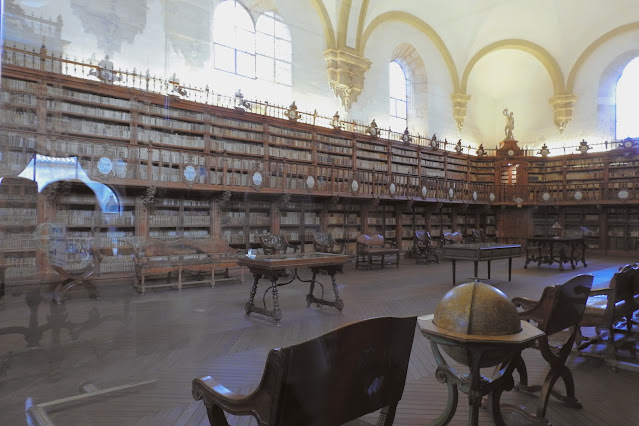 |
| The Old Library. The remodeling of the chapel led to construction in 1509 - 1526. Partially demolished in 1664 and rebuilt in 1794. |
 |
| There are 2, 805 manuscripts, with the oldest dating to the 11th century and 485 of which are incunabula. Over 60,000 works were printed between the 16th century and 1830. |
 |
| Most of the buildings in Salamanca are made of golden sandstone (piedra dorada), as was the cathedral. |
 |
| The sandstone allowed for easier carving of scenes depicted on the building, such as the birth of Jesus,... |
 |
| his triumphal entrance into Jerusalem as mentioned in all four gospels... |
 |
| and his crucifixion. |
 |
| In 1992 restorators added this modern touch with an astronaut... |
 |
| and a faun with an ice cream cone. |
We wended our way back down the Douro and hit Porto once more. Mary and Mike took off for home in Florida and Michael and I headed to the airport to catch our flight to Istanbul and the next leg of our journey. More on that later.
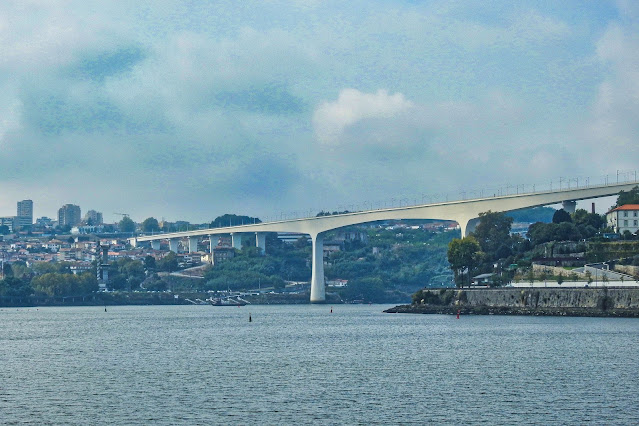 |
| Entering any city on the water gives you a totally different perspective and amazing views of the bridges crossing the Douro River. |
 |
| The contrast between the old iron railway bridge and the modern concrete bridge made for an interesting photo. |
 |
| The old walls of the city of Porto were also more evident from this vantage point. |
 |
| The cable cars stretched above the rabelos with the names of the different Port producers. The Sandeman building can be seen in the middle. |
 |
| The theater is visible on the left and the cathedral on the right. |
 |
As we got closer to our destination the fog started rolling in, which made sight seeing much more difficult for us and these smaller tour boats.
Below is one of the markers directing the way on the Camino de Compestela. The symbol represents a scallop shell, which was used as an early marker for the camino, and was on the Casa de Concha in Salamanca.
|
 |
| The rose window of the Cathedral of Porto, constructed under the direction of D. Alfonso Enriques, the father of the nation, in order to get the Pope to declare Portugal a new kingdom. |
 |
| The Porto train station, São Bento, was designed by José Marques da Silva. |
 |
| All train stations must have accurate clocks and Porto is no different. |
 |
| The more than 20,000 azulejos tiles depicting historic scenes and events in Portugal were painted and installed by Jorge Colaço between 1905 and 1906. Here is a depiction of the grape harvest,... |
 |
| and here rabelos on the Douro. |
 |
| This scene depicts the procession of Senhora dos Remédios in Lamego. |
 |
| Above the azulejos tiles are polychromatic tiles depicting other scenes as well. |
 |
| This depicts the entrance to Porto of King John I & Phillipa of Lancaster to celebrate their wedding in 1387. |
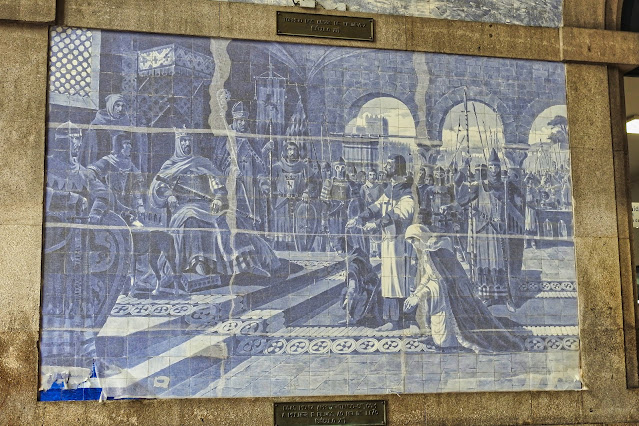 |
| This depicts the knight Egas Moniz offering his life, his wife and his sons to Alfonso VII of Leon in Toledo following the seige of Guimares in the 12th century. |






















































































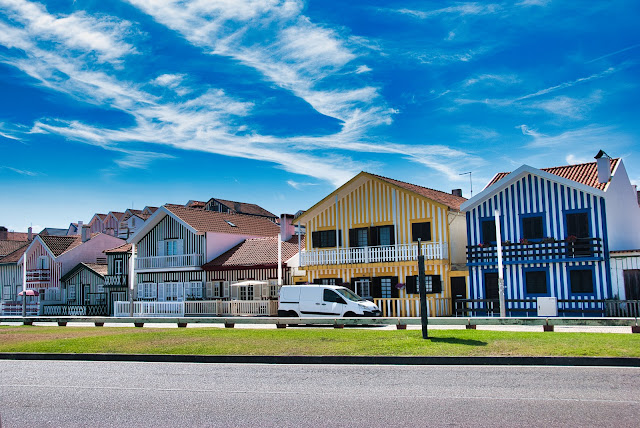









No comments:
Post a Comment